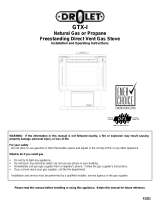
3
Radiance Direct Vent Gas Heater
20012697
The Radiance Direct Vent Room Heater, Model Nos. RADVTCB,
RADVTEB, RADVTMB, RADVTBS, RADVTCH, RADVTVG,
RADVTBD, RADVTBB, RADVTCG, RADVTGG, RADVTSG,
RADVTCCB, RADVTCEB, RADVTCMB, RADVTCBS, RAD
-
VTCCH, RADVTCVG, RADVTCBD, RADVTCBB, RADVTCCG,
RADVTCSG, is a vented gas appliance listed to the ANSI
standard Z21.88-2005 and CSA-2.33-2005 for Vented Room
Heaters, and CSA 2.17-M91, Gas-Fired Appliances For Use at
High Altitudes.
The installation of the Radiance Direct Vent Room Heater must
conform with local codes, or in the absence of local codes, with
National Fuel Gas Code, ANSI Z223.1/NFPA 54 — latest edi
-
tion and CSA B-149.1 Installation Code. (EXCEPTION: Do not
derate this appliance for altitude. Maintain the manifold pressure
at 3.5 inches w.c. for Natural Gas and 10 inches w.c. for LP gas
at maximum input.)
In the Commonwealth of Massachusetts:
• All gas fitting and installation of this heater shall only be
done by a licensed gas fitter or licensed plumber.
• A carbon monoxide detector must be installed in the same
room as the fireplace. (Refer to Regulation 248CMR 4.00
& 5.00 for more information.)
This appliance is only for use with the type of gas indicated on
the rating plate. This appliance is not convertible for use with
other gases unless a certified kit is used.
Installation and replacement of gas piping, gas utilization
equipment or accessories, and repair and servicing of equip
-
ment shall be performed only by a qualified agency, preferably
NFI or WETT (Canada) certified. The term “qualified agency”
means any individual, firm, corporation, or company that
either in person or through a representative is engaged in
and is responsible for (a) installation or replacement of gas
piping, or (b), the connection, installation, repair, or servic-
ing of equipment, who is experienced in such work, familiar
with all precautions required, and has complied with all the
requirements of the authority having jurisdiction.
The Radiance Direct Vent Room Heater should be inspected
before use and at least annually by a qualified service
agency. It is imperative that control compartments, burn
-
ers, and circulating air passageways of the appliance be
kept clean.
The Radiance Direct Vent Room Heater and its individual shut-off
valve must be disconnected from the gas supply piping during
any pressure testing of that system at test pressures in excess
of 1/2 psig (3.5 kPa).
The Radiance Direct Vent Room Heater must be isolated from
the gas supply piping system by closing its individual manual
shutoff valve during any pressure testing of the gas supply piping
system at test pressures equal to or less than 1/2 psig.
An accessible tap is located above the pilot/On-Off knob for
checking the inlet pressure.
‘Direct Vent’ describes a sealed combustion system in which
incoming outside air for combustion and outgoing exhaust en-
ter and exit through two separate concentric passages within
the same sealed vent system. The system does not use room
air to support combustion. The Direct Vent system permits the
gas appliance to be vented directly to the outside atmosphere
through the side of the house or vertically through the roof.
Conventional venting systems (Natural Vent) take air from the
room for combustion and vent the exhaust vertically through the
roof to the atmosphere.
This appliance is approved for bedroom installations in the U.S.
and Canada.
This appliance may be installed in an aftermarket* manufactured
(mobile) home, where not prohibited by state or local codes.
WARNING: Operation of this heater when not connected to a
properly installed and maintained venting system can result
in carbon monoxide (CO) poisoning and possible death.
The Radiance Direct Vent Room Heater, when installed, must
be electrically grounded in accordance with local codes or, in
the absence of local codes, with the National Electrical Code
ANSI/NFPA 70, (latest edition), or of the current Canadian
Electrical Code C22.1.
Due to high temperatures this appliance should be located
out of traffic and away from furniture and draperies.
WARNING: This appliance is hot while in operation. Keep
children, clothing, and furniture away. Contact may cause
burns or ignition of combustible materials.
Children and adults should be alerted to the hazards of
high surface temperatures and should stay away to avoid
burns or clothing ignition. Young children should be care-
fully supervised when they are in the same room as the
appliance.
Clothing or other flammable materials should not be placed
on or near the appliance.
Any safety screen, glass or guard removed for servicing
an appliance must be replaced prior to operating the ap
-
pliance.
The appliance area must be kept clear and free from com-
bustible materials, gasoline, and other flammable vapors
and liquids.
The flow of combustion and ventilation air must not be ob
-
structed. The installation must include adequate accessibility
and clearance for servicing and proper operation.
WARNING: Do not operate the Room Heater with the glass
panel removed, cracked or broken. Replacement of the panel
should be done by a licensed or qualified service person.
Do not use this appliance if any part has been under water.
Immediately call a qualified service technician to inspect the
appliance and to replace any part of the control system and
any gas control which has been under water.
Do not burn wood, trash or any other material for which this
appliance was not designed. This appliance is designed to
burn either natural gas or propane only.
This gas appliance must not be connected to a chimney flue
serving a separate solid-fuel burning appliance.
CAUTION: Label all wires prior to disconnection when
servicing controls. Wiring errors can cause improper and
dangerous operation.
Verify proper operation after servicing.
* Aftermarket: Completion of sale, nor for purpose of resale,
from the manufacturer.
Installation & Operating Instructions





















